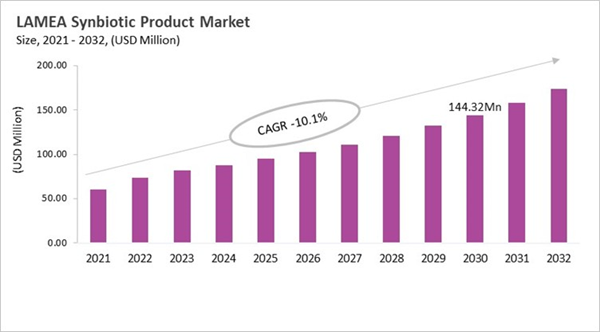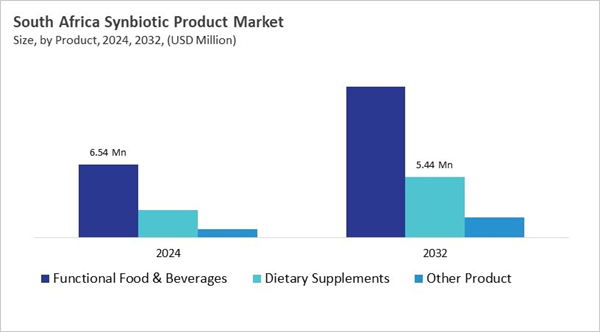The Brazil market dominated the LAMEA Synbiotic Product Market by country in 2024, and is expected to continue to be a dominant market till 2032; thereby, achieving a market value of $59.5 million by 2032. The Argentina market is showcasing a CAGR of 10.3% during 2025-2032. Additionally, the UAE market would register a CAGR of 7.4% during 2025-2032. The Brazil and South Africa led the LAMEA Synbiotic Product Market by Country with a market share of 36.8% and 9.6% in 2024.
The synbiotic market in Latin America, the Middle East, and Africa (LAMEA) is changing because of different food cultures, new rules, and more people being aware of health issues. People are used to eating fermented foods like kefir, amasi, and cassava-based products, which makes them more likely to accept scientifically made synbiotics. Regulatory bodies in Brazil, Argentina, South Africa, and the Gulf states are making probiotic and synbiotic standards more official. They are focusing on safety and clinical evidence. At the same time, universities and research institutions in the area are confirming health benefits, especially for digestive health, immunity, and child nutrition. This builds consumer trust and backs up government efforts to promote healthy eating.
Logistical problems, socioeconomic diversity, and limited infrastructure also affect market growth. This leads to new ideas in shelf-stable formats, encapsulation technologies, and low-cost delivery systems like fortified dairy, sachets, and drinks. Industry leaders, like the multinational companies Danone and Chr. Hansen uses regulatory engagement, partnerships with universities, and dual-market strategies to reach both high-end urban customers and low-end rural customers. Local cooperatives and startups add to this ecosystem by making synbiotics available in products that are easy to find or in niche biotech-driven products. The unique synbiotic market trajectory of LAMEA is shaped by these three factors: integrating public health, innovating for climate change, and forming strategic local partnerships. This balance of scientific credibility, affordability, and widespread adoption is what makes LAMEA's synbiotic market unique.
Distribution Channel Outlook
Based on Distribution Channel, the market is segmented into Offline, and Online. With a compound annual growth rate (CAGR) of 7.7% over the projection period, the Offline Market, dominate the Brazil Synbiotic Product Market by Distribution Channel in 2024 and would be a prominent market until 2032. The Online market is expected to witness a CAGR of 9.5% during 2025-2032.Product Outlook
Based on Product, the market is segmented into Functional Food & Beverages, Dietary Supplements, and Other Product. The Functional Food & Beverages market segment dominated the South Africa Synbiotic Product Market by Product is expected to grow at a CAGR of 9.7% during the forecast period thereby continuing its dominance until 2032. Also, The Dietary Supplements market is anticipated to grow as a CAGR of 10.6% during the forecast period during 2025-2032.Country Outlook
Brazil's synbiotic market is growing because people there are used to eating fermented foods and the government puts a lot of emphasis on safety and openness. People are open to functional foods that promote gut health because they already eat yogurt, kefir, and other foods that support the microbiome. This is because public health campaigns stress the importance of preventive nutrition. ANVISA's regulatory oversight makes sure that probiotics and prebiotics are well-documented, which allows for scientifically backed claims of well-being while limiting explicit health claims. There is clear market growth in fortified dairy, capsules, powders, and drinks, especially among city dwellers who can shop online. Both multinational and local companies are coming up with new ideas by changing their products, making them cheaper, and working with schools and businesses. This puts Brazil's synbiotic sector at the crossroads of global knowledge and culturally rooted eating habits.List of Key Companies Profiled
- Sabinsa Corporation (Sami-Sabinsa Group Ltd.)
- Danone S.A.
- Yakult Honsha Co., Ltd.
- Novozymes A/S (Novo Holdings A/S)
- Probiotical S.p.A.
- Lallemand Inc.
- Amway Corporation
- Kerry Group PLC
- Seed Health, Inc.
- Probi AB (Symrise AG)
Market Report Segmentation
By Distribution Channel
- Offline
- Online
By Product
- Functional Food & Beverages
- Dietary Supplements
- Other Product
By Country
- Brazil
- Argentina
- UAE
- Saudi Arabia
- South Africa
- Nigeria
- Rest of LAMEA
Table of Contents
Companies Mentioned
- Sabinsa Corporation (Sami-Sabinsa Group Ltd.)
- Danone S.A.
- Yakult Honsha Co., Ltd.
- Novozymes A/S (Novo Holdings A/S)
- Probiotical S.p.A.
- Lallemand Inc.
- Amway Corporation
- Kerry Group PLC
- Seed Health, Inc.
- Probi AB (Symrise AG)










